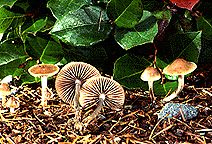
Get Sponsored


![]()
Hallucinogenic mushrooms have probably been in existance exactly as long as humanity. Ancient pictures of mushroom-headed humanoids have been found in caves in the Sahara. Siberian shamans use/d fly argarics to enlighten the path to the spiritworld. In Central and South Americiause of psilocybian mushrooms (and other hallucinogens) was common unutil the arrival of the Spaniards who spread the Catholic faith with sword and fire and forbade the use. Spanish priest Bernardio de Sahagun (ca. 1500ad) on the use of hallucinogenitic mushrooms by the Aztecs: "The first thing to be eaten at the feast were small small blck mushrooms that they called nanacatl and bring on drunkenness, hallunications and even lechery; they ate these before the dawn...with honey; and when they began to feel the effects; they began to dance, sing songs and others wept..... .... When the drunkenness of the mushrooms had passed, they spoke with one another of the visions they had seen." The Aztecs (1400-1521) took other hallucinogenitic drugs such as tlapatl, mixitl grain and peyotl or peyote, use of which originated from the north of Mexico, where it had been in use since 300bc. "Mushroom stones" in which figurews under the cap of a mushroom are depicted have been have been found from an even earlier era (1000-500bc) The purpose of these sculptures is not certain, but these stones may have been religious objects.

